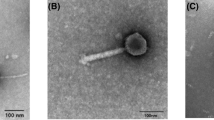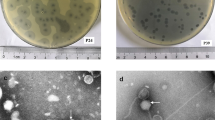Abstract
Pseudomonas cepacia strain 224c was subjected to treatment with two alternating cycles of penicillin andd-cycloserine in order to isolate spontaneous temperature-sensitive (ts) mutants. Of 150 surviving clones tested, ten were ts mutants; these were partially characterized, and one, Pcp-5, was chosen for experiments to determine the in vivo growth rate of the wild-type (wt) and clearance from the peritoneal cavities of mice. This mutant ceases growth almost immediately after transfer from 29°C to the nonpermissive (36°C) temperature and has a reversion rate of 10−8. In vivo experiments were performed by inoculating mixtures of Pcp-5 and wt into the peritoneal cavities of ICR mice. The ts mutant was cleared quantitatively (90% by 4 h), and the mean generation time (MGT) of the wt in the murine peritoneal cavity was 94 min.
Similar content being viewed by others
Literature Cited
Cash HA, Woods DE, McCullough B, Johanson WG, Jr Bass JA (1979) A rat model of chronic respiratory infection withPseudomonas aeruginosa. Am Rev Respir Dis 119:453–459
Gilligan PH, Schidlow DV (1984) The role ofPseudomonas cepacia in pulmonary disease of cystic fibrosis patients. Clin Microbiol Newsl 6:42–44
Isles A, Maclusky I, Corey M, Gold R, Prober C, Fleming P, Levison H (1984)Pseudomonas cepacia infection in cystic fibrosis: an emerging problem. J Pediatr 104:206–210
Krivan HC, Ginsburg V, Roberts DD (1988)Pseudomonas aeruginosa andPseudomonas cepacia isolated from cystic fibrosis patients bind specifically to gangliotetraosylceramide (asialo GM1) and gangliotriaosylceramide (asialo GM2). Arch Biochem Biophys 260:493–496
Lonon MK, Morris Hooke A (1990) Phospholipase C and egg yolk-reactive enzyme activities ofPseudomonas cepacia. Abstracts of the American Society for Microbiology 1990:58
Lonon MK, Woods DE, Straus DC (1988) Production of lipase by clinical isolates ofPseudomonas cepacia. J Clin Microbiol 26:979–984
McKevitt AL, Woods DE (1984) Characterization ofPseudomonas cepacia isolates from patients with cystic fibrósis. J Clin Microbiol 19:291–293
Morris Hooke A, Oeschger MP, Zeligs BJ, Bellanti JA (1978) Ideal target organism for quantitative bactericidal assays. Infect Immun 20:406–411
Morris Hooke A, Sordelli DO, Cerquetti MC, Vogt AJ (1985) Quantitative determination of bacterial replication in vivo. Infect Immun 49:424–427
Morris Hooke A, Bellanti JA, Oeschger MP (1985) Live attenuated bacterial vaccines: new approaches for safety and efficacy. Lancet i:1472–1474
Morris Hooke A, Sordelli DO, Cerquetti MC, Bellanti JA (1987) Differential growth characteristics and immunogenicity of tight and coasting temperature-sensitive mutants ofPseudomonas aeruginosa. Infect Immun 55:99–103
Rosenstein BJ, Hall DE (1980) Pneumonia and septicemia due toPseudomonas cepacia in a patient with cystic fibrosis. Johns Hopkins Med J 147:188–189
Sordelli DO, Cerquetti MC, Bellanti JA, Morris Hooke A (1987) Specific pulmonary defences againstPseudomonas aeruginosa after local immunization with temperature-sensitive mutants. J Gen Microbiol 133:2835–2841
Sordelli DO, Cerquetti MC, Fontan PA, Meiss RP (1989) Piroxicam treatment protects mice from lethal pulmonary challenge withPseudomonas aeruginosa. J Infect Dis 159:232–238
Starr MP, Burkholder WH (1941) Lipolytic activity of phytopathogenic bacteria determined by means of spirit blue agar and its taxonomic significance. Phytopathology 32:598–604
Tablan OC, Chorba TL, Schidlow DV, White JW, Hardy KA, Gilligan PH, Morgan WM, Carson LA, Martone WJ, Jason JM (1985)Pseudomonas cepacia colonization in patients with cystic fibrosis: risk factors and clinical outcome. J Pediatr 107:382–387
Tomashefski JF Jr, Thomassen MJ, Bruce MC, Goldberg HI, Konstan MW, Stern RC (1988)Pseudomonas cepacia-associated pneumonia in cystic fibrosis. Arch Pathol Lab Med 112:166–172
Author information
Authors and Affiliations
Rights and permissions
About this article
Cite this article
Hooke, A.M., Palecek, R.C., Palecek, T.M. et al. Spontaneous temperature-sensitive mutants ofPseudomonas cepacia: Isolation and utilization. Current Microbiology 22, 129–132 (1991). https://doi.org/10.1007/BF02105388
Issue Date:
DOI: https://doi.org/10.1007/BF02105388




